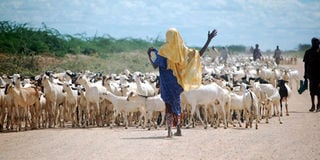Technology and innovation change face of pastoralism

A pastoralist gathers his herd in Hola for grazing. It was, and still is, widely believed that herders are primitive and inefficient users of natural resources. Similarly, overgrazing by livestock is often seen as the main cause of land degradation and desertification. PHOTO/LABAN WALLOGA
What you need to know:
- It is widely believed that herders are primitive and inefficient users of natural resources, but new research shows that by adopting the use of technology, such as mobile phones, pastoralism has become greener
- Pastoralists have often been blamed for environmental degradation because their animals overgraze, but new research suggests that mobile herding improves diversity of plant and animal species in arid areas;
- What’s more pastoralists have adopted new ways of conserving water and monitoring grazing lands that have made them more efficient, leading to greater milk production, better breeds and improved quality of life.
The development of pastoralism in Africa was a brilliant innovation.
Grasses and shrubs, which have little or no nutritional value for humans, were converted into nutritious milk, meat and blood from livestock.
According to recent scientific evidence, this ingenuity was home-grown as ancient African populations appear to have independently domesticated cattle.
Pastoralism has been criticised as a backward mode of production that ties its workers to poverty as well as leading to desertification and the decline of wild species.
However, the plight of pastoralists usually stems from ineffective government policies that have tried (or are trying) to change effective and viable production systems into something inferior, such as ranches of settled farming.
MORE PRODUCTIVE
Recent studies have shown that nomadic farming is 20 per cent more productive than ranching in terms of annual calf and milk production.
This has been widely documented in scientific literature.
In 1995, for example, Ian Scoones of the Institute of Development Studies at the University of Sussex in the UK, published Living With Uncertainty, in which he demonstrated that pastoralism is not only viable, but is by far the best option for drylands, and that African livestock systems can produce more energy, protein and cash per hectare than Australian and US ranches.
“Pastoralism is transforming but far from disappearing,” says Dr Jonathan Davies, the co-ordinator, of Global Drylands Initiative of the International Union for Conservation of Nature in Nairobi.
“The first claims of ‘pastoralism in decline’ were written in the 1920s, and their numbers have multiplied 10 times since then. People are very hasty to write them off.”
In spite of scepticism, and because of decades of failed state development plans and aid strategies, pastoralists in parts of Kenya (and in other areas of East Africa and the Horn of Africa) have started taking matters into their own hands and are making innovative changes in areas characterised by pasture shortages and water scarcity, livestock disease as well as institutional and political obstacles.
This should not be surprising, considering that pastoralism developed in response to increasing arid conditions. But the perennial stereotype is that pastoralists are resistant to change.
INNOVATIONS HAPPEN TOGETHER
“There is a lot of innovation going on, but it is not recorded and often not shared,” says Dr Scoones.
“Innovations often happen together: one follows another. Thus, the bringing of peace allowed children to go to school, opened up grazing and brought opportunities for the brokering of drought response strategies across communities.
Old technologies can be improved with new additions such as dams with plastic coatings on the bottom and new technologies can be deployed for old uses such as mobile phones for scouting for grazing and surveillance.”
In Somali-speaking areas of Kenya (and Ethiopia), changes are underway in water management, midwifery and pasture surveillance.
For example, herders now dig dams and line them with plastic. Water is then trucked and bowsers fill the dams.
In the past, women strained under the weight of jerry-cans filled with water on their backs but today they have found donkey carts can do the job just as well.
These herders are also using mobile phone technology to check pasture and water conditions as well as checking on security in their territory. Previously, scouts were dispatched for days at a time to check on such matters.
Even in areas where the United Nations or non-governmental organisations have intervened, these herders are making useful changes.
For example, Unicef provided “birthing kits” to pregnant mothers. However, the kits were too heavy and were disregarded until someone developed one that was safe, simple and portable. The kits are being sold in local shops today.
In the Pokot and Turkana regions, herders are not only using hay as a source of food for their livestock, but are also thinking in creatively regarding water management to improve grazing techniques.
Pastoralist innovations have come in response to climate change, which has made movement necessary even during wet periods.
In the Pokot region, when the herds trek to find the best grazing fields during the rainy season, some livestock (about five to 10 animals) remain in the permanent homesteads feeding on hay.
This is meant to provide milk, meat and blood for the families in the manyattas or homesteads (Pokot women traditionally took hay for calves and the weaker animals). Such a simple act has allowed Pokot children to stay at home and attend school. Hay is cut and stored for feeding in the dry season.
PRIMITIVE AND INEFFICIENT
Other changes have come about in the areas of pasture maintenance. For example, when Pokot women clear bush to improve grazing, they now seed such areas to improve the grazing potential.
Colonial and post-independence African governments believed that natural resources needed to be protected from traditional communities.
However, conservation schemes have deprived many pastoralist groups of valuable land and water resources.
Furthermore, national parks normally exclude human settlement and livestock foraging. Game reserves and controlled areas allow multiple uses, yet still have disadvantages.
Post-independence African governments continued the colonial trend of confiscating pastoralists’ land. Besides, African governments hardly consult or even communicate with indigenous peoples on the fate of their land.
It’s not surprising that these negative attitudes have led to failed policies. Behind these lay ancient and deeply rooted ethno-economic stereotypes, which still persist.
It was, and still is, widely believed that herders are primitive and inefficient users of natural resources. Similarly, overgrazing by livestock is often seen as the main cause of land degradation and desertification.
However, recent analysis shows that land degradation in dry land Africa has been overestimated.
Long-term satellite monitoring of biomass shows a cycle of contraction and expansion of the northern vegetation limits of the Sahel, and little has changed since 1970.
Where degradation occurred, it was usually due to long-term climatic trends and not primarily livestock.
SCIENTIFIC EVIDENCE
But in spite of the scientific evidence, the international community continues to be biased in favour of conserving Africa’s wildlife at the expense of supporting livestock development.
What the colonial and post-independence African governments failed to understand was that pastoralist communities have from time immemorial depended on their natural surroundings and, precisely for that reason, they have devised ways of sustaining their environment in the long run.
So pastoralists are directly responsible for the biodiversity, both plant and animal, that has made large parts of their homelands worthy of conservation as national parks or wildlife reserves.
“Pastoralists have historically helped maintain the rich range of biodiversity of pastoral lands which are filled with an impressive variety of animals and plants,” says Dr Jonathan Davies.
“This ecological wealth has translated into a wide variety of protected areas and national parks being located within pastoral areas, such as the Serengeti-Mara region of East Africa.”
Grazing by pastoralists stimulates the growth of pastures and improves mineral and water processes.
Rangelands and grasses have co-evolved with herbivores and depend on herbivore action for seed dispersal, seed fecundity (improved – for some grasses – by passage through the rumen), breakdown of ligneous vegetation (e.g. old grass matter), manuring, and a number of other actions.
If you remove herbivores from the system, it can degrade surprisingly quickly. Under-grazing is often as much a problem as over-grazing, but we don’t really understand it well enough.
Even in the face of the present land grabs of African land by foreign countries and companies, innovative adaptation to change is taking place.
The Orma of Kenya’s Tana Delta are facing such a challenge. Huge tracts of land in the Tana Delta, a critical source of dry season pasture for the Orma, are being set aside for large industrial-scale farming by the Kenyan government for export crops, bio-fuels and minerals.
And the deals are sizeable: 40,000 ha, 90,000 ha and 120,000 ha are on the table.
SHARED, VITAL RESOURCE
The delta is also a vital source of water during severe dry periods. During the 2009 drought, there were an estimated 3 million heads of cattle in the Delta, coming from as far as Wajir.
Individually titled lands in the settlement schemes are now being fenced, denying grazing access to the Orma, who used these lands for many years.
More than 25,000 people living in 30 villages stand to be evicted from their ancestral land in favour of these schemes after communities from outside the pastoral areas were settled there to undertake crop farming.
According to officials of the Ministry of Lands in Tana River district, such settlement schemes should have been distributed in the proportion of 70 per cent to local communities and 30 per cent to Kenyans.
But the reality on the ground indicates that less than five per cent of the farms were actually allocated to local pastoralists.
With the fencing of the farms, the pastoralists have lost a critical grazing pasture in the delta, and conflicts between the pastoralists and the farmers are likely to intensify, particularly during the dry seasons or when drought strikes.
These land deals and settlement schemes have led to restricting access to key resources for pastoralists, but these have in turn led to innovative ways of pastoralists accessing such key resources.
The Orma have established grazing corridors, stretching from the edge of the Tsavo to Garsen, all the way to Witu in Lamu West in the delta region.
So, on one side they neighbour the Tsavo National Park and the Agricultural Development Corporation’s (ADC) Galana ranch.
The pastoralists are marking corridors to save them from land grabbers, in essence “grabbing” the corridors for themselves as a grazing/land protection strategy.
They have also begun buying hay and renting farm residues for their weaker livestock. These activities are gaining more currency as a means of accessing high-value fodder for their livestock.
Thus the political economy of the Orma is increasingly getting linked to the market economy, and this is giving rise to new social organisations and land tenure arrangements.
WOMEN RISING
Orma women have also come to the forefront.
The emergence of markets and the opportunities for commercialisation have given rise to women entrepreneurs who trade in livestock and livestock products.
Women are increasingly gaining control of their own incomes from the sale of livestock, milk and value addition to milk in the form of “labania”.
To make their livestock marketable, the Orma are changing various aspects of their pastoralism.
For starters, their herding strategies and livestock preferences are evolving to respond to markets by seeking high-value fodder to fatten animals.
There have also been new developments in communications and transport to deliver animals and livestock products to markets; creating more decentralised livestock sale yards to supply itinerant traders seeking animals for urban and regional markets; and cross-breeding to improve breeds.
Livestock auctions are giving transporters an opportunity to take the animals to the end-markets such as Mombasa and Mariakani.
Individual/private ownership of land is increasingly replacing communal ownership and land-based resources, with serious negative implications for poorer pastoralists who can neither join socially organised groups nor own their own pieces of land.
The new Constitution has created a National Land Commission which could provide some reprieve from the land “rush” currently taking place in the delta, but the commercialisation of the Orma pastoral economy is not expected to reduce, but rather, intensify in coming years.
- Digging dams and lining them with plastic, then getting bowsers to fill them with water
- Using donkey-drawn carts instead of carrying jerricans themselves
- Using mobile technology to scrutinise pasture and water conditions
- Using hay as a source of food for their animals
- Borrowing Unicef’s idea to make a more user-friendly birthing kit
- Keeping a few animals back home to provide nourishment when others are grazing
- “Grabbing’ land to create migration corridors




